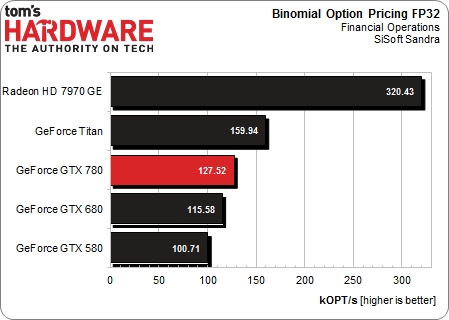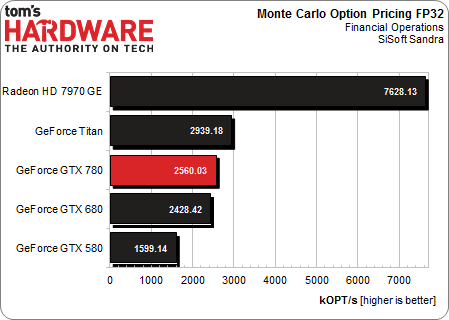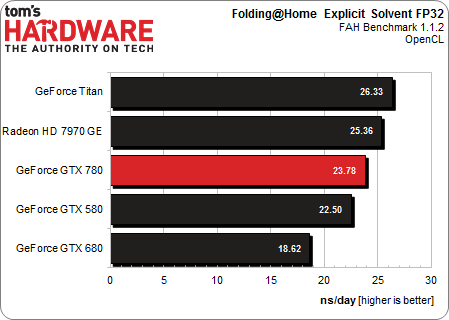Nvidia GeForce GTX 780 Review: Titan’s Baby Brother Is Born
At $1,000, GeForce GTX Titan only made sense for folks building small form factor PCs and multi-GPU powerhouses. Now there's another option with every bit of panache, a slightly de-tuned GPU, and a price tag $350 lower: meet Nvidia's GeForce GTX 780.
OpenCL: Single-Precision
We chose not to rely on the typical computing tests this time around, since we're specifically trying to isolate and compare single- and double-precision math performance. After all, like GeForce GTX Titan, the 780 is a descendant of the powerful Tesla cards. So, we're using metrics that let us test both levels of precision.
Financial Analysis Performance (Float/FP32)
Remarkably, the GeForce GTX 780 ends up closer to the 680 than the Titan.
Folding@Home (FP32)
The Folding@Home benchmark puts Nvidia's GeForce GTX 780 exactly halfway between the GeForce GTX Titan and GeForce GTX 680.
Looking at these results, two things become clear. First, Nvidia regrettably still appears to treat OpenCL as a second-class API. Second, the F@H benchmark proves that porting a CUDA application to OpenCL is not as trivial as it may sound. While the GeForce cards dominate when it comes to protein folding with the explicit solvent, AMD’s Radeon HD 7970 GHz Edition comes out on top in financial analysis performance.
Of course, it’s easy to find other benchmarks that show either one or the other company in the lead, but that’s not what we're after. Rather, we want to show how our field performs in these same tests switching to double-precision.
Get Tom's Hardware's best news and in-depth reviews, straight to your inbox.
Current page: OpenCL: Single-Precision
Prev Page CUDA Performance Next Page OpenCL: Double-Precision-
CrisisCauser A good alternative to the Titan. $650 was the original GTX 280 price before AMD came knocking with the Radeon 4870. I wonder if AMD has another surprise in store.Reply -
It's definitely a more reasonable priced alternative to the titan, but it's still lacking in compute. Which might disappoint some but I don't think it'll bother most people. Definitely not bad bang for buck at that price range considering how performance scales with higher priced products, but it could've been better, $550-$600 seems like a more reasonable price for this.Reply
-
hero1 This is what I have been waiting for. Nice review and I like the multi gpu tests. Thanks. Time to search the stores. Woohoo!!Reply -
natoco To much wasted silicon (just a failed high spec chip made last year, even the titan) and rebadged with all the failed sections turned off. I wanted to upgrade my gtx480 for a 780 but for the die size, the performance is to low unfortunately. It has certainly not hit the trifecta like the 680 did. Would you buy a V8 with 2 cylinders turned off even if it were cheaper? No, because it would not be as smooth as it was engineered to be, so using that analogy, No deal. customer lost till next year when they release a chip to the public that's all switched on, will never go down the turned off parts in chip route again.Reply -
EzioAs In my opinion, this card and the Titan is actually a clever product release by Nvidia. Much like the GTX 680 and GTX 670, the Titan was released at higher price (like the GTX 680) while the slightly slower GTX 780 (the GTX670 for the GTX600 series case) is at a significantly lower price but performing quite close to it's higher-end brother. We all remember when the GTX 670 launched it makes the GTX680 looks bad because the GTX 670 was 80% of the price while maintaining around 90-95% of the performance.Reply
Of course, one could argue that as we get closer to higher-end products, the performance increase is always minimal and price to performance ratio starts to increase, however, for the past 3-4 years (or so I guess), never has it been that the 2nd highest-end GPU having such low performance difference with the highest-end GPU. It's usually significant enough that the highest end GPU (GTX x80) still has it's place.
Tl;dr,
The GTX Titan was released to make the GTX 780 look incredibly good, and people (especially on the internet), will spread the news fast enough claiming the $650 release price for the GTX 780 is good and reasonable, and people who didn't even bother reading reviews and benchmarks, will take their word and pay the premium for GTX 780.
Nvidia is taking a different route to compete with AMD or one could say that they're not even trying to compete with AMD in terms of price/performance (at least for the high-end products). -
mouse24 natocoTo much wasted silicon (just a failed high spec chip made last year, even the titan) and rebadged with all the failed sections turned off. I wanted to upgrade my gtx480 for a 780 but for the die size, the performance is to low unfortunately. It has certainly not hit the trifecta like the 680 did. Would you buy a V8 with 2 cylinders turned off even if it were cheaper? No, because it would not be as smooth as it was engineered to be, so using that analogy, No deal. customer lost till next year when they release a chip to the public that's all switched on, will never go down the turned off parts in chip route again.Reply
Thats apretty bad analogy. A gpu is still smooth even with some of the cores/vram/etc turned off, it doesn't increase latency/frametimes/etc. -
godfather666 "But, I’m going to wait a week before deciding what I’d spend my money on in the high-end graphics market. "Reply
I must've missed something. Why wait a week? -
JamesSneed Natoco, your comment was so clueless. It is likely every single CPU or GPU you have ever purchased has fused off parts. Even the $1000 extreme Intel cpu has a little bit fused off since its a 6 core CPU but using a 8 core Zeon as its starting point. Your comparison to a car is idiotic.Reply -
016ive You will have to be an idiot to buy a Titan now that the 780 is here...Me, I could afford neither :)Reply




